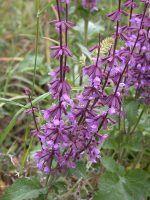 Native to Mediterranean woodlands and shrub lands, this tender herbaceous perennial is a member of the deadnettle family, Lamiaceae, that also includes mint, rosemary, and beebalm. The plants grow up to 3′ tall and have 4-angled, stiff stems carrying paried, wrinkled leaves with toothed margins. From mid-spring into summer the 3/4″ long violet flowers are borne in whorls of 6-12 and are strongly 2-lipped. The inflorescence consists of a strong central spike and 3 pairs of lateral branches that bend upwards and inwards. Historians think that the inflorescence resembles a menorah, the seven-branched Jewish ceremonial candlestick. The plant has been used since ancient times as a medicinal herb and is an attractive addition to a medicinal herb garden or garden border. The genus name, Salvia, comes from the Latin salvere, meaning to save, and refers to the healing properties of the plant. The specific epithet, judaica, is from the Hebrew יהודה, Yehudah, Judah, the name given to the mountaious southern part of the Land of Israel.
Native to Mediterranean woodlands and shrub lands, this tender herbaceous perennial is a member of the deadnettle family, Lamiaceae, that also includes mint, rosemary, and beebalm. The plants grow up to 3′ tall and have 4-angled, stiff stems carrying paried, wrinkled leaves with toothed margins. From mid-spring into summer the 3/4″ long violet flowers are borne in whorls of 6-12 and are strongly 2-lipped. The inflorescence consists of a strong central spike and 3 pairs of lateral branches that bend upwards and inwards. Historians think that the inflorescence resembles a menorah, the seven-branched Jewish ceremonial candlestick. The plant has been used since ancient times as a medicinal herb and is an attractive addition to a medicinal herb garden or garden border. The genus name, Salvia, comes from the Latin salvere, meaning to save, and refers to the healing properties of the plant. The specific epithet, judaica, is from the Hebrew יהודה, Yehudah, Judah, the name given to the mountaious southern part of the Land of Israel.
Type: Tender herbaceous perennial
Bloom: Whorls of 6-12 violet, 2-lipped flowers from mid spring into summer
Size: 3′ H x 3′ W
Light: Full sun to partial shade
Soil: Average, medium moist, well-drained
Hardiness: Zones 8-11
Care: Low maintenance
Pests and Diseases: None of significance
Propagation: Seed
Companion Plants: Zinnia, petunia, marigold
Outstanding Selections: Unknown
Photo Credit: Gideon-Pisanty-Wikipedia